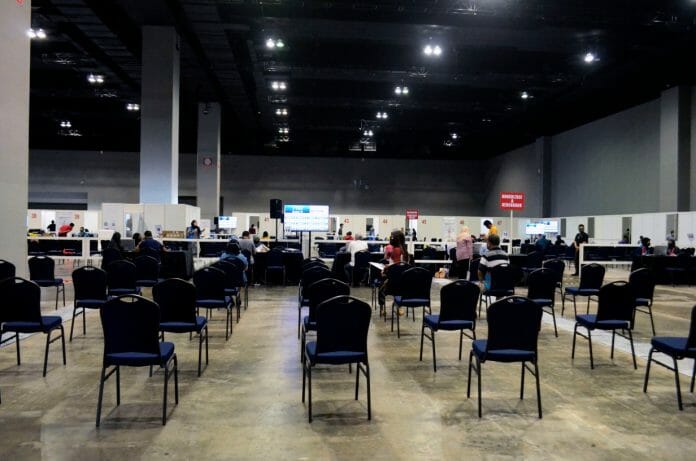The once-promising pace of Covid-19 vaccination in the United States has slowed, from a peak of 3.38 million shots on April 13, 2021, to fewer than 2 million doses per day in May. Until recently, Americans were competing for limited vaccination slots — a situation that raised equity concerns — but now supply exceeds demand in much of the country, and mass vaccination clinics are closing. There is a concern this scenario could play out in Malaysia as well, once the cases go down would citizens return to the ‘tidak-apa’ attitude?
Despite having inoculated half of its people, the United States remains far from the herd-immunity target of roughly 80%: with approximately 47% of Americans have received at least one dose of Covid-19 vaccine. What can it do to motivate millions more to participate?
It has been identified, that increasingly that standard “information and education” approaches to encouraging vaccination are inadequate, in some of the state governments and businesses are starting to pay people to get vaccinated. Incentives range from RM400 savings bonds or gift cards in West Virginia, to free beer and other beverages in New Jersey and Connecticut, to daily Krispy Kreme donuts nationwide. The highest stakes are in New York, which is offering a lottery with a RM20 million grand prize, and Ohio, where five lotteries will each award RM4 million to a vaccinated adult and a full-ride college scholarship to a vaccinated child. Do such incentives represent a desirable path forward?
There is a certain logic to providing financial incentives, which may be used to offset the indirect costs of vaccination — including time spent planning appointments, traveling, or waiting; lost income for workers paid hourly; or expenses such as child care. These costs disproportionately deter low-income people from getting vaccinated, and payments could ensure that vaccination is indeed “free” to all.
Moreover, economists typically acknowledge that there is a role for government intervention in the face of externalities — effects of individuals’ actions on other people. A classic negative externality is a factory polluting the air: absent government sanctions, many factories would “overproduce” pollution, since dirtier technology is cheaper. Vaccination confers a positive externality, protecting other people as well as the vaccinee. In a free market, people may undervalue the beneficial effect of their actions on others; goods with positive externalities may therefore end up being underproduced. Subsidies and incentives are a logical policy approach in the presence of positive externalities.
In addition, incentives are useful in situations where behavior changes can reduce future health expenditures.
Finally, incentives can shift even intractable health behaviors, such as cigarette smoking and physical inactivity, though people may revert to those behaviors when the incentives end. Incentives are thus particularly effective in changing one-time behaviors — such as obtaining cancer screening and vaccinations.
Given flagging vaccination rates and the societal imperative to end the pandemic, financial incentives hold appeal, especially if an incentive-based program were focused on groups with persistently low vaccination rates. Some people who are reluctant to be vaccinated might opt to get the vaccine “because of the incentive,” thereby overcoming inertia or resistance from their peer group.
Even if incentives can produce a short-term bump in vaccination, however, multiple strategies will be necessary to increase population immunity. Campaigns will have to identify sources of resistance, including safety concerns (e.g., for pregnant women), and communicate transparently to build public trust.
It’s important to consider that booster shots will probably be required down the line. Offering incentives now may set a costly and undesirable precedent, causing people to expect — and wait for — an incentive the next time around.
Ultimately, though a well-designed incentive program could boost vaccination rates in the short term, there are likely to be significant hiccups in implementation, and delivering timely rewards flawlessly would be key to program effectiveness and credibility. Three alternative strategies should be considered wherever feasible, since they present more sustainable solutions than incentives for boosting vaccination.
First, organizations that take care of patients could mandate Covid vaccination for their employees. No intervention strategy is more effective than requiring vaccination, vaccination mandates in schools and workplaces — especially in high-contact settings such as pasar borongs, construction sites, prisons and construction sites — could substantially reduce the future toll of Covid-19.
Second, access to activities that involve close person-to-person contact could be granted only to vaccinated people. This approach can open doors to largely elite pursuits, such as live attendance at the football games, both domestic and overseas, or University enrollment. Some educational institutions have highlighted the fact that by making full in-person participation in higher education contingent on getting vaccinated, they will also be lowering risk in the surrounding community. Restaurants, gyms, and sports stadiums have been struggling with limited person capacity, they now can opt for giving those vaccinated a special seating space or sections.
Such contingent access is a social incentive, rather than a financial one, and the desire to “return to normal” is likely to be a powerful motivator. The broader the range of organisations that adopt such policies, the bigger the proportion of the population that will opt for vaccination.
A third option is to raise health and life insurance premiums for people who forgo vaccination. This approach could redistribute the higher expected health care costs in a way that is fair to people who have already been vaccinated.
Incentives alone are unlikely to deliver the population immunity that will end the pandemic. We need to go further in adopting a combination of behaviorally informed policies that will protect our health and the health of the economy for years to come.
-The New England Journal of Medicine









